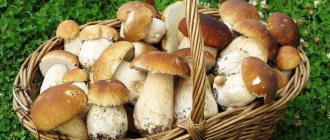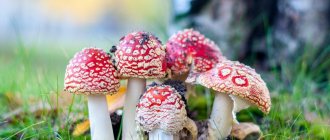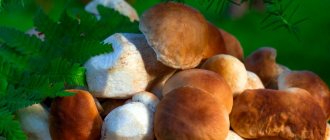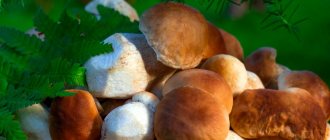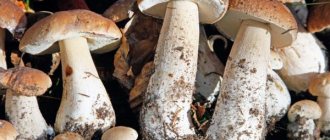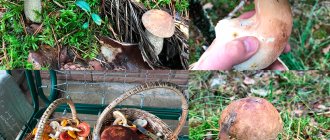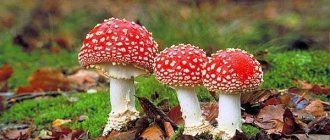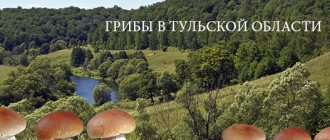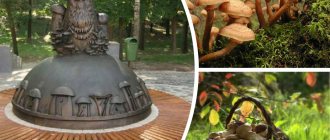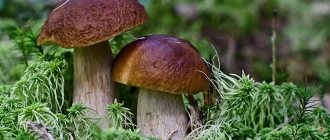Mushroom connoisseurs always look forward to the picking season.
And armed with baskets, knives and mosquito repellent, they go to the treasured fruitful places, which will undoubtedly delight them with prey. There are enough mushroom forests in the Leningrad region. Experienced mushroom pickers know which forest will delight you with full baskets. Dear readers! For you, we have created communities on social networks in which useful articles and interesting ideas are published several times a day! Subscribe and receive useful content in a convenient format!
What is this episode about?
In the summer of 2016, as part of our project “Briefly and clearly about the most interesting things,” a wall newspaper “Mushrooms of the Leningrad Region” was published with photographs of 62 of our most common species.
However, the diversity of mushrooms in the Leningrad region amounts to thousands of species. Mushrooms can be found in all types of forests, in fields and meadows, in swamps, vegetable gardens and even on city lawns. Judging by the reviews, the topic turned out to be very interesting, and we are happy to continue it. In this issue you will find species rare for our forests, meeting which for a person knowledgeable in mushrooms is always a joyful event. We will also introduce you to a very special group of organisms - lichens. These are not just mushrooms, and not plants, but a symbiosis of fungi, algae and cyanobacteria. Lichens literally surround us: about a thousand of their species have been registered in the Leningrad region, but few can name at least a couple. The material of this wall newspaper (as well as issue No. 96) was prepared by specialists of the St. Petersburg Mycological Society.
See also wall newspapers: “Walks along the shore of the Gulf of Finland”, part and, “Traces of forest animals”, “Plants of the Leningrad Region”, part and, “Who lives in the forest?”, “Birds of the Leningrad Region”, part and, “Reserved territories of the Leningrad Region” , “Reserved territories of St. Petersburg”, “Fishes of the Leningrad region”, “Butterflies of the Leningrad region”, “Rare birds of the Leningrad region”, “Beasts of our forests”, “Wildlife of the parks of our city” and other issues of the series “Nature of the native land”.
Lichens (lat. Lichenes) are a special group of organisms. Fungal cells form a body within which algal and/or cyanobacterial cells are located. The mushroom receives nutrients from its neighbors, creating an optimal microclimate for them in return.
Based on their appearance, lichens are divided into foliose, fruticose and crustose lichens.
Foliaceous lichens look like plates of different shapes and sizes; they are attached to the substrate with the help of outgrowths of the lower crustal layer.
In fruticose lichens, the body forms many round or flat branches. Such lichens can grow both on the ground and hang from trees, wood debris, and rocks.
The body of crustose lichens is a crust (“scale”), its lower surface grows tightly with the substrate and does not separate without significant damage. Crustose lichens can live on steep mountain slopes, trees, and even concrete walls.
There are many transitional forms.
Lichens are adapted to extremely unfavorable conditions of temperature and humidity and grow wherever life is possible. They go further north than any Arctic plant, but they also thrive in tropical rainforest.
Lichens play a significant role in the soil-forming process, as they gradually destroy the wood and rocks to which they are attached. The fungi that make up some lichens contain various pigments. One of them (orcein) is used for dyeing wool, the other (litmus) is widely used in chemical laboratories as an indicator of the acidity of the environment.
The classification of lichens currently follows the rules for the classification of fungi, so the name lichen is the scientific name of the fungus that forms its body. The algae has its own, separate name and can be found in nature independently of the fungus. Lichens belong to the fungal kingdom.
There are more than 20,000 species of lichens. About 1000 species have been recorded in the Leningrad Region, of which 68 species are included in the Red Book of St. Petersburg, and 94 species are included in the Red Book of the Leningrad Region (2018 data).
We thank lichenologist, senior lecturer at the Department of Botany of St. Petersburg State University, researcher at the Laboratory of Lichenology and Bryology of the BIN RAS Dmitry Evgenievich Gimelbrant for valuable consultations.
Trumpet chanterelle
This mushroom got its name for a reason - its stem is hollow inside, and in mature fruiting bodies a small hole opens in the center of the cap.
The color is very different from other chanterelles. The cap is brownish or gray-yellow on top, sometimes with a red tint. Most often it occurs with noticeable scales. The bottom is wrinkled with plates, much lighter (up to almost white). The leg is chrome-yellow, turning pale with age. Dimensions are smaller than those of the common chanterelle: up to 6 cm in diameter and up to 8 cm in height.
The trumpet fox clearly prefers coniferous trees to deciduous trees, therefore it is found in the corresponding forests - pine, spruce or mixed forests. Also, according to some information, it is not only capable of forming mycorrhiza, but also feeding on wood debris - like a typical saprophyte. It bears fruit throughout the autumn season - until the first slight frost; at the peak of fruiting, mushrooms appear en masse, in friendly clusters.
Popular articles Transplanting thuja at different times of the year: what you need to know for this
It is not inferior in taste to the common chanterelle, although it has noticeably tougher flesh, which confuses some gourmets. To level out this drawback, the mushroom has to be subjected to heat treatment for longer.
Foliose lichens
Family Lobariaceae – Lobariaceae
Family Parmeliaceae – Parmeliaceae
Family Peltigeraceae
Family Teloschistaceae – Teloschistaceae
Family Umbilicariaceae
Family Physciaceae
Forest dangers
When entering the forest, you should not forget about the danger that may await you. First of all, you need to charge your phone battery well and take with you a first aid kit with the first essentials. A compass will not be amiss in your pocket. It's worth taking mosquito repellent too. Walk with a stick in your hands. Use it to check dense bushes as snakes may be hiding there.
If the forest is unfamiliar, do not go far from your friend so as not to get lost. Wear high shoes made of thick material. Clothing should fit snugly along its entire length. This will protect you from ticks.
Mushroom places in the Gatchina region sometimes have many snakes. But remember, the poisonous ones do not attack first. Newspaper headlines also scare mushroom pickers about bears. But such a meeting is rare. If you do encounter a dangerous animal, be calm - any wild animal is afraid of you just as much as you are of it. In order not to irritate the animal, just do not move. The time of year is no less important. At the end of summer or beginning of autumn, bears have already restored the fat layer that they need for hibernation. Therefore, they will not attack first.
Fruticose lichens
Family Cladoniaceae
Family Parmeliaceae – Parmeliaceae
Famous places
The area is rich in mushroom places
- Agalatovo village: small, beautiful and cozy, with about 2000 houses. It stands on the banks of the Okhta River. There is a highway nearby. The railway station is 18 km away. There are a lot of mushrooms. Honey mushrooms can be collected even on the street, along the road.
- Microdistrict "Berngradovka": located in Vsevolozhsk. Next to it is Lake Ladoga. It's easy to get there. Both trains and buses go to the designated place. There are a lot of mushrooms there; local residents constantly collect whole baskets, prepare crops for the winter and sell part of what they get at a profit.
- Melnichny Ruchey village: located in the suburbs of Vsevolozhsk. The nature there is incredibly beautiful. It’s worth going there just to admire the local flavor. There are a lot of mushrooms, but still not as much as in Berngradovka.
- village of Novoye Devyatkino: located along the highway. The Okhta River flows nearby. Thanks to its convenient transport links, it is popular among mushroom pickers. And there are more than enough mushroom glades there. Local residents even hold competitions in the area to see who can score the most.
- village named after Morozov: located on the right bank of the Niva. The village can be reached by rail and by car. There are many different mushrooms found there. This year, honey mushrooms have been particularly abundant.
For convenience, a special map was created showing places rich in caps.
Crustose lichens
Family Lecanoraceae – Lecanoraceae
Family Icmadophilaceae
Family Phlyctidaceae
Who are my clients
Everyone buys mushrooms from me: men and women, old and young. Housewives admire each mushroom, close the jars according to family recipes, boil, fry, make julienne and carpaccio.
Restaurants also buy mushrooms. The chefs personally evaluate the quality and process the mushrooms for their menu. A buyer from a restaurant at the Astoria Hotel called me and asked me to bring mushrooms straight from the forest, but only when the chef was on site. He accepts unusual products personally.
They are bought by mushroom pickers who cannot go into the forest themselves. My beloved client used to go into the forest on her own, but now she is sick and cannot walk for a long time. Another regular customer is a member of the board of directors of a large company. A couple of times a season he finds time and goes mushroom hunting with us. He collects one or two baskets of all sorts of things for fun, and then orders ten kilograms of boletus mushrooms from me. He wants to freeze elite mushrooms for the winter, but lacks the skills to collect them himself.
What to read about lichens?
– Zavarzin A. A., Gimelbrant D. E., Alekseeva N. M. Lichens. Series “Naturewatch-Baltic Library”. St. Petersburg, 2000. – 146 p.
– Shapiro I. A. Lichens are amazing organisms and indicators of the state of the environment: a manual for teachers and high school students. SPb.: Christmas+. 2003. – 108 p.
– Shapiro I. A. Mysteries of the sphinx plant. – L.: Gidrometeoizdat, 1991. – 80 p.
– Lichen flora of Russia: biology, ecology, diversity, distribution and methods of studying lichens / Responsible. ed. M. P. Andreev, D. E. Gimelbrant. – M.; St. Petersburg: Partnership of Scientific Publications KMK, 2014. – 392 p.
Mushrooms are amazing creatures. They belong neither to animals nor to plants, but are endowed with individual properties of both. For example, they do not contain chlorophyll, which is characteristic of green plants, but they do have chitin, which is found in animals. Mushrooms form an independent kingdom of nature - True mushrooms (Mycota or Fungi) - one of eight, which have been identified by many taxonomists since 1998, and are also part of two more: Chromista and Protozoa.
For scientists, a mushroom is a mycelium (mycelium) that develops underground or in wood. This is a single long-lived organism that often occupies vast territories. In North America, in the state of Oregon, in 1998, perhaps the largest organism on our planet was discovered - the mycelium of the honey fungus, 8 thousand years old with a total area of about 10 square kilometers. There are probably larger and older ones. In one area of the forest, mycelium of different species peacefully coexist (or compete).
Many mushrooms are a kind of “forest orderlies”. They promote the decomposition of diseased trees, fallen leaves and other organic matter, while forming fertile soils. Fungi are often members of communities that arise as a result of mutually beneficial relationships between different organisms. Well-known lichens, for example, are a symbiosis of fungi and algae (or bacteria). Without the “help” of fungi, herbivores would not be able to digest food. Yeast, one of the oldest domesticated organisms, is also a fungus, only one-celled. Fungi are also actively used in modern biotechnological production, for example, to obtain antibiotics.
For mushroom pickers, macromycetes are of interest, that is, those mushrooms whose fruiting bodies (reproductive organs) can be seen with the naked eye. These are the ones we collect, admire, photograph or study. Macromycetes are extremely varied in shape and size and can come in all colors of the rainbow. Some cover a tree trunk with a wrinkled film for several meters, others stretch into the sky, resembling a space rocket in shape, and others form a mighty cap the size of a car wheel. And if you look closely at small mushrooms, you can find many interesting creatures, including surprisingly elegant, stunningly beautiful specimens, and sometimes huge clusters of them. With serious magnification, many mushrooms will appear before us in a completely different light. Small round hats will turn out to be openwork umbrellas, and poorly visible plates will turn out to be graceful branched veins...
Macromycete fungi are very numerous; more than one hundred thousand species have now been discovered. Including in St. Petersburg and the Leningrad region, which are famous for their amazingly diverse nature, up to ten thousand. The vast majority of mushrooms growing in our area are not known to the general public. Not all little-known species are truly rare. However, not all rare species are subject to state protection. Currently, the number of mushrooms included in the Red Data Books of the Russian Federation and its individual regions is relatively small. These lists are updated from time to time with new species and those included there by mistake are removed.
It is interesting that mushrooms can also be collected in the cold season. First of all, these are winter honey mushrooms, “plantations” of which can be found on trees all winter, of course, if there are no severe frosts and heavy snowfalls. The first lines of spring begin in the fall. The strongest boletus, boletus and Polish mushrooms can survive until the very frost.
In our forests there are several hundred edible species of mushrooms (the rest of the mushrooms are either not edible, poisonous, or have not yet been tested for edibility or toxicity). Now the basket also includes species that were previously not customary to collect: ringed cap, funnel-shaped funnel, pink lacquer, even matsutake row, which is extremely rare here, but very popular in Japan. Despite this, the most important advice: collect only those mushrooms that you know well. If you have even the slightest doubt that the mushroom you found is edible, do not eat it under any circumstances! Also, you should not take a mushroom if it looks old or unusual in any way. Do not collect mushrooms along highways, in city parks, or in polluted places. And do not buy mushrooms secondhand, because it is not known where they were collected.
Mycologists - scientists who study mushrooms - willingly collaborate with amateur mushroom pickers. In order to unite the efforts of scientists and mushroom pickers, in 2011 at the Botanical Institute. V.L. Komarov created the St. Petersburg Mycological Society. SPbMiko is the first public association in Russia of people who deeply and sincerely love forests and mushrooms, who want to study these wonderful organisms and promote knowledge among the multi-million army of mushroom pickers. The Society organizes exhibitions of live mushrooms in the Botanical Garden twice a year, publishes the Planet of Mushrooms magazine and popular science literature, helps create Red Books of Russian regions and justify the organization of new reserves.
This issue of the wall newspaper, prepared by the Society’s specialists, will also serve to popularize knowledge about the mushroom kingdom.
Conventional and edible mushrooms, where to look and collect?
In addition to the usual places that have been adopted in recent years, more experienced mushroom pickers can go looking for mushrooms in “secret” places. You shouldn’t think that their territories are classified on the map; it’s just that lovers of quiet hunting, who have been collecting mushrooms for many years, highlight the most fertile points for themselves, returning there every year. The coming year is no exception to the rule! Some collect full buckets, others leave the forest with empty baskets.
When going in search of certain types of mushrooms, it is recommended to make the right choice in favor of coniferous or deciduous plantings. An alternative would be a mixed zone, implying the presence of both trees.
Helpful information!
To collect mushrooms for pickling for the winter, it is recommended to take a knowledgeable mushroom picker with many years of experience with you on the search. He will help you decide on a place for a quiet hunt, and most importantly, he will share secrets and subtleties during the collection. If you don’t have such an acquaintance, you can try asking on social networks that fishing enthusiasts take a newcomer for company. Women are better off turning to the fair sex or married couples for their safety.
Division Basidial – Basidiomycota
Family Agaricaceae – Agaricaceae
Boletaceae family – Boletaceae
Family Ganodermataceae – Ganodermataceae
Family Hericiaceae
Family Hymenogasteraceae – Hymenogastraceae
Family Gyroporaceae
Family Gomphaceae
Lyophyllaceae family – Lyophyllaceae
Chanterelle family – Cantharellaceae
Family Meripilaceae – Meripilaceae
Family Meruliaceae – Meruliaceae
Fly agaric family – Amanitaceae
Family Cobwebs – Cortinariaceae
Family Pleurotaceae – Pleurotaceae
Family Pluteaceae
Family: Tricholomataceae
Family Pigweed – Paxillaceae
Family Sparassidaceae
Russulaceae family – Russulaceae
Family Physalacriaceae
Family Fistulinaceae
Family Exidiaceae – Exidiaceae
Family Telephoraceae – Thelephoraceae
Mushroom pleasure
So the journey on the map, where mushroom places are indicated, has ended. Leningrad region is open for search
When collecting forest delicacies, you should not forget about precautions, which are often forgotten due to the overwhelming joy of the find. You should only collect familiar mushrooms so as not to harm your life and health, first of all, your own, and secondly, your family and customers.
Myceliums are a network of small tubes connecting teams of caps in one small area, and therefore if there is one good mushroom in a clearing, then there are probably a bunch of his friends located somewhere nearby. The main quality of a mushroom picker, or any hunter, is attentiveness.
For harvesting, it is better to use containers where free air exchange will occur, such as a basket or mesh. This way, wild mushrooms will not spoil before they get home, and lovers of delicious food will be able to enjoy an excellent delicacy at the table.
Division Marsupials – Ascomycota
Family Discinaceae – Discinaceae
Family Sarcosomaceae – Sarcosomataceae
Sarcoscyphaceae family
Legend
What mushrooms grow in St. Petersburg?
The forest lands here delight with harvests of boletus, boletus and porcini mushrooms
, however, there is a military training ground nearby, which is unsafe.
The area around the village of Pervomaisky is also considered mushroom places
in St.
Petersburg The catch is the noble white and their valuable cousins: boletus and boletus.
Interesting materials:
How to change sleep mode? How do I change how I pay for my Uber ride? How to change your mortgage rate? How to change the desktop style? How to change MBR table to GPT? How to change the theme in Odnoklassniki? How to change the color of the Start menu bar? How to change the panel color on a computer? How to change the font color on the taskbar? How to change font color in Notepad?
